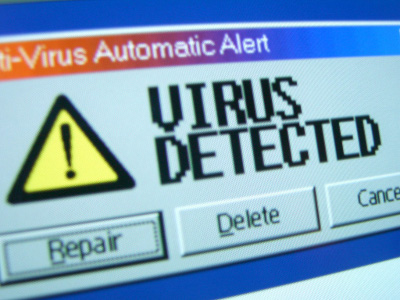
In the early years floppy disks (removable media) were in fact the prevalent method used to spread viruses. Bulletin boards and online software exchange systems emerged as major channels for the spread of viruses in the late 80s. Ultimately of course, the internet in all its forms became the major source of infection.
Our timeline for PC Virus history, is as follows:
1944
In Theory John von Neumann – the brilliant mathematician who helped bring us nuclear energy, game theory and quantum theory’s operating mechanics – theorized about the existence of computer viruses as early 1944. In a series of lectures called “Theory of self-reproducing automata” von Neumann contemplated the difference between computers and the human mind, and also about the possibility of self-relicating computer code.
Considering the modern computer virus is, essentially, self-replicating computer code adds to von Neumann’s impressive academic achievements, as such code is commonplace today.
1982
The first externally released virus is thought to be 'Elk Cloner', written by Rich Skrenta. It infected Apple DOS 3.3 computers, and spread via floppy disk.
This, of course, opened the way for viruses to really spread. A program called Elk Cloner, written by a 15-year-old, spread itself via floppy disks. Like Creeper it really didn’t do a lot of damage; it would occasionally display a poem taunting the end-user and simply spread itself.

Rich Skrenta, the virus’s creater, called it “some dumb little practical joke.” That may have been so to him, but viruses would soon grow far beyond that.
The 1980s would see viruses appear for all the major platforms including IBM, Amiga, and even BSD UNIX. The diversity of computer operating systems on the market prevented viruses from spreading too quickly, however. That would change in the 90s.
1983
The term 'computer virus' begins to emerge. This is often credited to Fred Cohen of the University of Southern California.
1986
Early PC viruses start to appear. One of the first, emerging from Pakistan, is known as the 'Brain' and is a 'boot sector' virus (floppy disk).
1987
The first 'file' viruses begin to appear (largely affecting the essential system file command.com).
1988
The ARPANET worm, written by Robert Morris, disables approx 6,000 computers on the network.
The well known (at the time) Friday the 13th virus is released in this year.
The Cascade virus, thought to be the first encrypted virus, is discovered. is found
1989
The AIDS trojan appears. It was fairly unique at the time because it demanded payment for removal.
1990
Anti-virus software begins to appear
1991
Norton Anti-Virus software is released by Symantec. The first widely spread polymorphic virus (one which changes its appearance as it spreads), "Tequila", is released.
1992
Well over 1,000 viruses are now thought to exist.
1994
The first major virus hoax, known as "Good Times" surfaces
1995
The first major 'Word' virus emerges, known as "Concept"
1999
The "Melissa" virus, written by David L. Smith, infects countless thousands of PCs (estimated damage = $80 million). It replicates by sending copies of itself to addresses in the Microsoft Outlook address book. The author is subsequently jailed for 20 months.
2000
In May of this year, the 'I Love You' virus, written by a Filipino student, infects millions of PCs. It is similar to "Melissa" but sends passwords back over the network.
2001
In July, the Code Red worm infects thousands of Windows NT/2000 servers, causing $2 billion in damages (estimated)
2003
In January the "Slammer" worm spreads at the fastest rate thus far, and infects hundreds of thousands of PCs.
There are more MS-DOS/Windows viruses than all other types of viruses combined (by a large margin). Estimates of exactly how many there are vary widely and the number is constantly growing.
In 1990, estimates ranged from 200 to 500; then in 1991 estimates ranged from 600 to 1,000 different viruses. In late 1992, estimates were ranging from 1,000 to 2,300 viruses. In mid-1994, the numbers vary from 4,500 to over 7,500 viruses. In 1996 the number climbed over 10,000. 1998 saw 20,000 and 2000 topped 50,000. It's easy to say there are more now. Indeed, in April 2008, the BBC reported that Symantec now claims "that the security firm's anti-virus programs detect to 1,122,311" viruses and that "almost two thirds of all malicious code threats currently detected were created during 2007."
The confusion exists partly because it's difficult to agree on how to count viruses. New viruses frequently arise from someone taking an existing virus that does something like put a message out on your screen saying: "Your PC is now stoned" and changing it to say something like "Donald Duck is a lie!". Is this a new virus? Most experts say yes. But, this is a trivial change that can be done in less than two minutes resulting in yet another "new" virus.
More confusion arises with some companies counting viruses+worms+Trojans as a unit and some not.
Another problem comes from viruses that try to conceal themselves from scanners by mutating. In other words, every time the virus infects another file, it will try to use a different version of itself. These viruses are known as polymorphic viruses.
One example, the Whale (an early, huge, clumsy 10,000 byte virus), creates 33 different versions of itself when it infects files. At least one vendor counted this as 33 different viruses on their list. Many of the large number of viruses known to exist have not been detected in the wild but probably exist only in someone's virus collection.
David M. Chess of IBM's High Integrity Computing Laboratory reported in the November 1991 Virus Bulletin that "about 30 different viruses and variants account for nearly all of the actual infections that we see in day-to-day operation." In late 2007, about 580 different viruses, worms, and Trojans (and some of these are members of a single family) account for all the virus-related malware that actually spread in the wild. To keep track visit the Wildlist, a list which reports virus sightings.
How can there be so few viruses active when some experts report such high numbers? This is probably because most viruses are poorly written and cannot spread at all or cannot spread without betraying their presence. Although the actual number of viruses will probably continue to be hotly debated, what is clear is that the total number of viruses is increasing, although the active viruses not quite as rapidly as the numbers might suggest.
Summary
By number, there are well over 100,000 known computer viruses.
Only a small percentage of this total number account for those viruses found in the wild, however. Most exist only in collections.
This is in no way complete, but a brief outline of the start and progression of the virus phenomena.
Do you have any cool stories from the early history of computer viruses? Please share!









